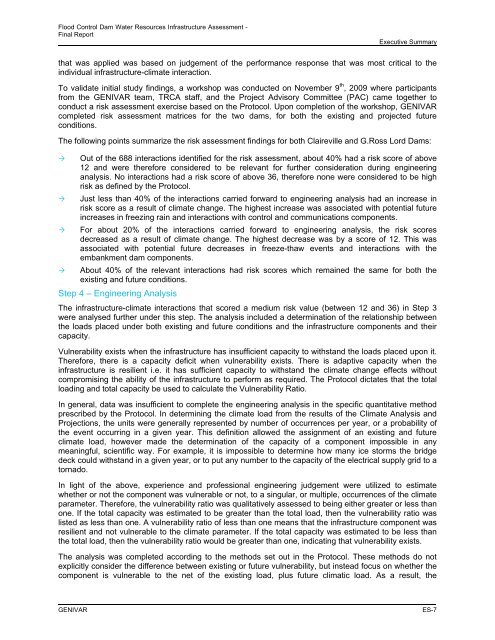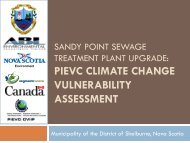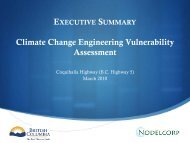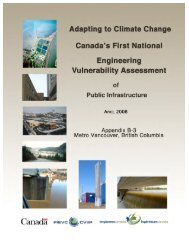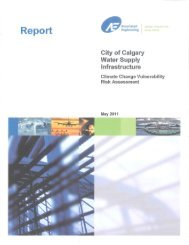Final Report - Vulnerability Committee
Final Report - Vulnerability Committee
Final Report - Vulnerability Committee
Create successful ePaper yourself
Turn your PDF publications into a flip-book with our unique Google optimized e-Paper software.
Flood Control Dam Water Resources Infrastructure Assessment -<strong>Final</strong> <strong>Report</strong>Executive Summarythat was applied was based on judgement of the performance response that was most critical to theindividual infrastructure-climate interaction.To validate initial study findings, a workshop was conducted on November 9 th , 2009 where participantsfrom the GENIVAR team, TRCA staff, and the Project Advisory <strong>Committee</strong> (PAC) came together toconduct a risk assessment exercise based on the Protocol. Upon completion of the workshop, GENIVARcompleted risk assessment matrices for the two dams, for both the existing and projected futureconditions.The following points summarize the risk assessment findings for both Claireville and G.Ross Lord Dams:Out of the 688 interactions identified for the risk assessment, about 40% had a risk score of above12 and were therefore considered to be relevant for further consideration during engineeringanalysis. No interactions had a risk score of above 36, therefore none were considered to be highrisk as defined by the Protocol.Just less than 40% of the interactions carried forward to engineering analysis had an increase inrisk score as a result of climate change. The highest increase was associated with potential futureincreases in freezing rain and interactions with control and communications components.For about 20% of the interactions carried forward to engineering analysis, the risk scoresdecreased as a result of climate change. The highest decrease was by a score of 12. This wasassociated with potential future decreases in freeze-thaw events and interactions with theembankment dam components. About 40% of the relevant interactions had risk scores which remained the same for both theexisting and future conditions.Step 4 – Engineering AnalysisThe infrastructure-climate interactions that scored a medium risk value (between 12 and 36) in Step 3were analysed further under this step. The analysis included a determination of the relationship betweenthe loads placed under both existing and future conditions and the infrastructure components and theircapacity.<strong>Vulnerability</strong> exists when the infrastructure has insufficient capacity to withstand the loads placed upon it.Therefore, there is a capacity deficit when vulnerability exists. There is adaptive capacity when theinfrastructure is resilient i.e. it has sufficient capacity to withstand the climate change effects withoutcompromising the ability of the infrastructure to perform as required. The Protocol dictates that the totalloading and total capacity be used to calculate the <strong>Vulnerability</strong> Ratio.In general, data was insufficient to complete the engineering analysis in the specific quantitative methodprescribed by the Protocol. In determining the climate load from the results of the Climate Analysis andProjections, the units were generally represented by number of occurrences per year, or a probability ofthe event occurring in a given year. This definition allowed the assignment of an existing and futureclimate load, however made the determination of the capacity of a component impossible in anymeaningful, scientific way. For example, it is impossible to determine how many ice storms the bridgedeck could withstand in a given year, or to put any number to the capacity of the electrical supply grid to atornado.In light of the above, experience and professional engineering judgement were utilized to estimatewhether or not the component was vulnerable or not, to a singular, or multiple, occurrences of the climateparameter. Therefore, the vulnerability ratio was qualitatively assessed to being either greater or less thanone. If the total capacity was estimated to be greater than the total load, then the vulnerability ratio waslisted as less than one. A vulnerability ratio of less than one means that the infrastructure component wasresilient and not vulnerable to the climate parameter. If the total capacity was estimated to be less thanthe total load, then the vulnerability ratio would be greater than one, indicating that vulnerability exists.The analysis was completed according to the methods set out in the Protocol. These methods do notexplicitly consider the difference between existing or future vulnerability, but instead focus on whether thecomponent is vulnerable to the net of the existing load, plus future climatic load. As a result, theGENIVARES-7


